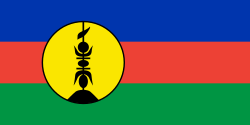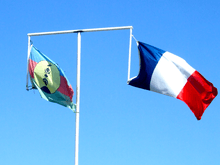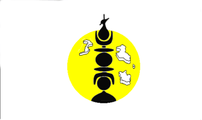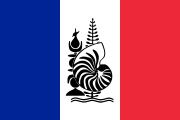Flags of New Caledonia
Two flags are in use in New Caledonia, an overseas territory of France. Up to 2010, the only flag used to represent New Caledonia was the flag of France, a tricolor featuring three vertical bands coloured blue (hoist side), white, and red known to English speakers as the French Tricolour or simply the Tricolour. However, in July 2010, the Congress of New Caledonia voted in favour of a wish to fly the Kanak flag of the independentist movement FLNKS alongside the French tricolor. The wish, legally non-binding, proved controversial. [1][2]. A majority of Neo-Caledonian communes, but not all, now fly both flags, the rest flying only the Tricolour.[3]
 Both flags used by New Caledonia | |
 National flag, always used | |
| Name | Tricolore |
|---|---|
| Proportion | 2:3 |
| Adopted | 15 February 1794 |
| Design | A vertical tricolour of blue, white, and red. |
 FLNKS flag, often used | |
| Name | Kanak Flag |
| Proportion | 1:2 |
| Adopted | 13 July 2010[1] |
| Design | A horizontal tricolour of blue, red, and green charged with a yellow disc fibrated black and defaced with a black flèche faîtière. |
Overview

In 2008, the government of New Caledonia debated the introduction of an official regional flag and anthem, as required by the Accord de Nouméa. A flag in fairly widespread unofficial use was the flag of the Kanak and Socialist National Liberation Front (FLNKS), a political party favoring independence for New Caledonia, thus a highly polemical emblem, and the French tricolor would remain the only flag used for the next two years.
In July 2010, the Congress of New Caledonia voted in favour of a non legally binding wish (vœux) to fly the Kanak flag alongside the French tricolor in the territory.[2][1] On 17 July 2010, French Prime minister François Fillon took part in a ceremony in Nouméa where the FLNKS flag was hoisted alongside the French tricolor.[4][5] The coexistence with the pro independentist flag proved controversial, with the Neo-Caledonian deputy to the National Assembly Gaël Yanno calling it "akin to rising the Palestinian flag over the Knesset". In the capital city Noumea, the first rise of the FLNKS flag on the town hall happened without any ceremony, as the mayor refused to participate. The Neo-Caledonian delegation to the Olympic Games used the combined flags for the first time in 2011.[6] According to Philippe Gomès, then President of the Government of New Caledonia, "this flag was imposed to us. Is it representative of all communities? No, it's the flag of the Kanak, the flag of independence. Is it the choice of all? No, it's the choice of a lone man who chose to play along with the independentist".[7] Thus, the debate on finding a permanent official regional flag continued[8] as the adoption of the Kanak flag proved controversial.[4] Some New Caledonians argued for a completely new flag for New Caledonia, which would incorporate designs from both the French tricolor and the Kanak flags.[4] Such new flag would aim to promote a "common destiny" for ethnic Kanaks and ethnic French residents in New Caledonia.[4]
FLNKS political flag
The FLNKS flag, first adopted by the party in 1980, is composed of three horizontal stripes of blue (Pantone 286c), red (Pantone 032c) and green (Pantone 347c) charged with a yellow (Pantone 102c) disc of a diameter two-thirds the height of the flag centered at a position of one-third the width of the flag, measured from the hoist side. The disc is fibrated black and defaced with a vertical symbol, also black.
The blue symbolizes both the sky and more importantly the ocean surrounding New Caledonia. The red symbolizes the blood shed by the Kanaks in their struggle for independence, socialism, and unity. The green symbolizes the land itself and by extension the ancestors buried within it. The yellow disc is a representation of the sun and the symbol upon it consists of a flèche faitière, a kind of arrow that adorns the roofs of Kanak houses thrust through tutut shells.[9]
Provincial flags
New Caledonia is divided into three provinces, each with its own flag.
 Flag of South Province
Flag of South Province Flag of North Province
Flag of North Province Flag of the Loyalty Islands
Flag of the Loyalty Islands
Other flags
 One of the various flags used to represent the New Caledonian team at the Pacific Games, all of which depict a stylized cagou in the center[10]
One of the various flags used to represent the New Caledonian team at the Pacific Games, all of which depict a stylized cagou in the center[10] French tricolour defaced with New Caledonia's emblem
French tricolour defaced with New Caledonia's emblem.svg.png) Flag used to represent New Caledonia by FIFA
Flag used to represent New Caledonia by FIFA
See also
References
- Transcript from the official text in french, see discussion for a translated version
- Voeux n° 1 du treize juillet 2010
- Roch Wamytan: "descendre le drapeau kanak est un geste ignoble, il ne faut plus parler de destin commun!"
- Malkin, Bonnie (20 July 2010). "New Caledonia adopts second flag in compromise over French rule". The Daily Telegraph. Retrieved 28 July 2010.
- "FLNKS flag" (in French). 17 July 2010. Retrieved 17 July 2010.
- A Nouméa, Sarkozy et la question du double drapeau
- Législatives: quand le communautarisme fait gagner des voix en Nouvelle-Calédonie
- La Nouvelle-Calédonie se cherche toujours un drapeau
- "Front de Libération National Kanak Socialist (Political party, New Caledonia)". 27 April 2014. Retrieved 31 January 2016.
- http://www.crwflags.com/fotw/flags/oly@nc.html
External links
| Wikimedia Commons has media related to Flags of New Caledonia. |